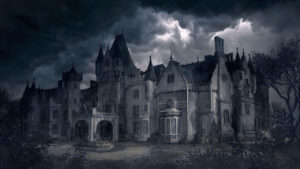Jharol F. Aguirre
May 8th, 2018
Glossary Entry

Gothic in relation to “Christabel”
As defined by the Merriam dictionary, the word gothic is a style of architecture that is prevalent in Western Europe. But it can also be defined as the state of Europe during the dark ages (19th century), the whole continent felt gloomy and looked horrifying. Today we often connect the word gothic to literature by referring to the gothic fiction genre that includes works of literature that possess gothic characteristics, a good example would be “Christabel” by Samuel T. Coleridge. But before we dive into the gothic analysis of the poem “Christabel” we need to understand what gothic literature is.
Gothic Literature uses specific settings, these settings commonly include dark and desolate areas such as haunted castles, unknown regions, and the innermost parts of the human mind. The settings are then accompanied by menacing and sinister sounds such as the screeching of animals, ticking noises (Clocks and Heartbeats), and whispers. The poem “Christabel” is a prime example of gothic literature because it contains the quintessential gothic characteristics that were mentioned before like dark scenery, hint of the supernatural, the sounds of howling dogs and ticking clocks. The Gothic nature of “Christabel” is evident throughout the poem, Gothic undertones are first noted as the poem begins with “Tis the middle of night by the castle clock” and “the owls have awakened the crowing cock” (part 1, 1-2), these lines prepare the reader for the negative things that are to come. The menacing tone of the poem continues while Coleridge writes of dark clouds, a full moon, and chilly air. The negative connotation of these descriptions makes the reader feel uneasy. The feeling of dread increases while Coleridge describes Christabel’s reaction to the noise she heard. He writes, “Hush, beating heart of Christabel! Jesu, Maria, shield her well!”(54-53). At this point, the reader expects the worst.
The events of “Christabel” are tragic and scary, but they are even more horrifying because Coleridge does not explain them. There is no way to determine if Geraldine is an evil being, or if she is only influenced by an evil being. As Coleridge never finished his poem, there is no way to be certain. Supernatural powers are certainly involved, but there is no way to know their full extent. It is this element of the unknown that makes “Christabel,” and Gothic literature in general, so horrifying.
Work Cited
“Gothic.” Merriam-Webster, https://www.merriam-webster.com/dictionary/Gothic
“Gothic Fiction” Study.com, https://study.com/academy/lesson/gothic-fiction-definition-characteristics-authors.html

